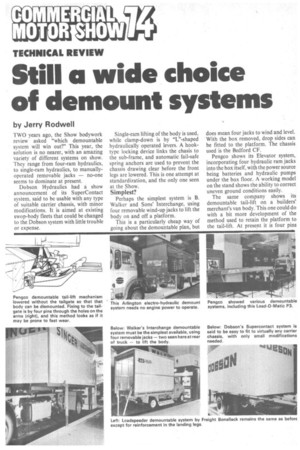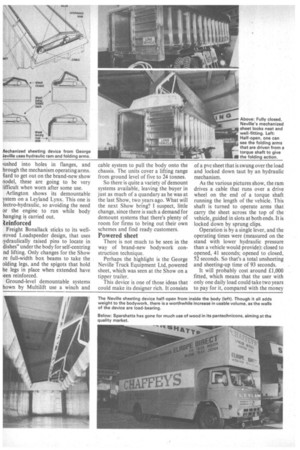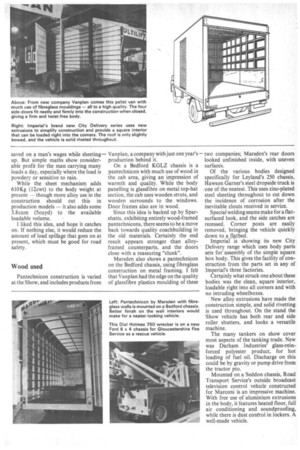Still a wide choice of demount systems
Page 55

Page 56

Page 57

If you've noticed an error in this article please click here to report it so we can fix it.
by Jerry Rodwell
TWO years ago, the Show bodywork review asked "which demountable system will win out?" This year, the solution is no nearer, with an amazing variety of different systems on show. They range from four-ram hydraulics, to single-ram hydraulics, to manuallyoperated removable jacks — no-one seems to dominate at present.
Dobson Hydraulics had a show announcement of its SuperContact system, said to be usable with any type of suitable carrier chassis, with minor modifications. It is aimed at existing swop-body fleets that could be changed to the Dobson system with little trouble or expense. Single-ram lifting of the body is used, while clamp-down is by "L"-shaped hydraulically operated levers. A hooktype locking device links the chasis to the sub-frame, and automatic fail-safe spring anchors are used to prevent the chassis drawing clear before the front legs are lowered. This is one attempt at standardization, and the only one seen at the Show.
Simplest?
Perhaps the simplest system is B. Walker and Sons' Interchange, using four removable wind-up jacks to lift the body on and off a platform.
This is a particularly cheap way of going about the demountable plan, but does mean four jacks to wind and level. With the box removed, drop sides can be fitted to the platform. The chassis used is the Bedford CF.
Pengco shows its Elevator system, incorporating four hydraulic ram jacks into the box itself, with the power source being batteries and hydraulic pumps under the box floor. A working model on the stand shows the ability to correct uneven ground conditions easily.
The same company shows its demountable tail-lift on a builders' merchant's van body. This one could do with a bit more development of the method used to retain the platform to the tail-lift. At present it is four pins pushed into holes in flanges, and hrough the mechanism operating arms, lard to get out on the brand-new show nodel, these are going to be very !ifficult when worn after some use.
Arlington shows its demountable ystem on a Leyland Lynx. This one is lectro-hydraulic, so avoiding the need or the engine to run while body hanging is carried out.
Zeinforced
Freight Bona!lack sticks to its wellToyed Loadspeeder design, that uses Lydraulically raised pins to locate in dishes" under the body for self-centring nd lifting. Only changes for the Show re full-width box beams to take the olding legs, and the spigots that hold he legs in place when extended have ieen reinforced.
Ground-level demountable systems hown by Multilift use a winch and cable system to pull the body onto the chassis. The units cover a lifting range from ground level of five to 24 tonnes.
So there is quite a variety of demount systems available, leaving the buyer in just as much of a quandary as he was at the last Show, two years ago. What will the next Show bring? I suspect, little change, since there is such a demand for demount systems that there's plenty of room for firms to bring out their own schemes and find ready customers.
Powered sheet
There is not much to be seen in the way of brand-new bodywork construction technique.
Perhaps the highlight is the George Neville Truck Equipment Ltd, powered sheet, which was seen at the Show on a tipper trailer.
This device is one of those ideas that could make its designer rich. It consists of a pvc sheet that is swung over the load and locked down taut by an hydraulic mechanism.
As the various pictures show, the ram drives a cable that runs over a drive wheel on the end of a torque shaft running the length of the vehicle. This shaft is turned to operate arms that carry the sheet across the top of the vehicle, guided in slots at both ends. It is locked down by sprung clips.
Operation is by a single lever, and the operating times were (measured on the stand with lower hydraulic pressure than a vehicle would provide): closed to opened, 41 seconds; opened to closed, 52 seconds. So that's a total unsheeting and sheeting-up time of 93 seconds.
It will probably cost around £1,000 fitted, which means that the user with only one daily load could take two years to pay for it, compared with the money saved on a man's wages while sheeting up. But simple maths show considerable profit for the man carrying many loads a day, especially where the load is powdery or sensitive to rain.
While the sheet mechanism adds 610 Kg (12 cwt) to the body weight at present — though more alloy use in the construction should cut this in production models — it also adds some 3.8 cum (5 cuyd) to the available loadable volume.
I liked this idea, and hope it catches on. If nothing else, it would reduce the amount of load spillage that goes on at present, which must be good for road safety.
Wood used
Pantechnicon construction is varied at the Show, and includes products from Vanplan, a company with just one year's production behind it.
On a Bedford KGLZ chassis is a pantechnicon with much use of wood in the cab area, giving an impression of warmth and quality. While the body panelling is glassfibre on metal top-hat section, the cab uses wooden struts, and wooden surrounds to the windows. Door frames also are in wood.
Since this idea is backed up by Sparshatts, exhibiting entirely wood-framed pantechnicons, there seems to be a move back towards quality coachbuilding in the old materials. Certainly the end result appears stronger than alloyframed counterparts, and the doors close with a reassuring "clunk".
Marsden also shows a pantechnicon on the Bedford chassis, using fibreglass construction on metal framing. I felt that Vanplan had the edge on the quality of glassfibre plastics moulding of these two companies; Marsden's rear doors looked unfinished inside, with uneven surfaces.
Of the various bodies designed specifically for Leyland's 250 chassis, Hawson Garner's steel dropside truck is one of the neatest. This uses zinc-plated steel sheeting throughout to cut down the incidence of corrosion after the inevitable clouts received in service.
Special welding seams make for a flatsurfaced look, and the side catches are recessed, Corner posts are easily removed, bringing the vehicle quickly down to a flatbed.
Imperial is showing its new City Delivery range which uses body parts sets for" assembly of the simple square box body. This gives the facility of construction from the •parts set in any of Imperial's three factories.
Certainly what struck one about these bodies was the clean, square interior, loadable right into all corners and with no intruding wheelboxes.
New alloy extrusions have made the construction simple, and solid rivetting is used throughout. On the stand the Show vehicle has both rear and side roller shutters, and looks a versatile machine.
The many tankers on show cover most aspects of the tanking trade. New was Darham Industries' glass-reinforced polyester product, for hot loading of fuel oil. Discharge on this could be by gravity or pump drive from the tractor pto.
Mounted on a Seddon chassis, Road Transport Service's outside broadcast television control vehicle constructed for Marconi is an impressive machine. With free use of aluminium extrusions in the body, it features heated floor, full air conditioning and soundproofing, while there is dust control in lockers. A well-made vehicle.




























































































































































